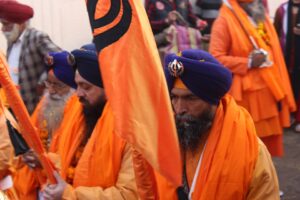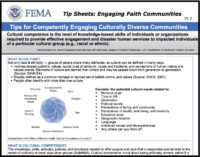In this tip sheet, you will discover foundational information to help you interact with Sikh leaders. It is part of a set of tools and training for FEMA to help disaster response professionals engage with faith communities. Much of the information also can help students, researchers, government agencies, non-profits and businesses learn about and develop relationships with communities. Click here for the PDF version of this tip sheet.
Religion Called: The Sikh (commonly pronounced seek, properly pronouced “sick”) faith, Sikhi, or Sikhism
Adherents Consider Themselves: Sikhs
House of Worship: Gurdwara a.k.a. temple
First Point of Contact: President of board of directors
Religious Leader: No ordained leaders; a Gyani leads prayer and Granthi may lead worship
Spoken Direct Address: Use “Sardar Sahib” for males and “Sardarani Sahiba” for females
Physical Interaction: Handshake O.K. across genders
HOUSE OF WORSHIP
Sikh houses of worship are called gurdwaras, which are commonly referred to as temples in English. Typically, a gurdwara includes a commercial kitchen as well as a hall for community worship and meals (langar hall).
RELIGIOUS LEADERS
Ordained/Commissioned/Licensed Leaders
- Sikhism has no clergy. Religious services may be lead by either a Granthi (specially trained to lead worship) or any baptized adult member of the community who wears the required articles of faith, male or female.
Lay Leaders
Sikhism teaches egalitarianism and a leveling of caste distinctions. Therefore, the role and place of women is parallel to that of men, but preferences for men in leadership roles may be present in communities.
- Gyani (or giani): A man who sings sacred prayers – specially trained and knowledgeable of Sikhism.
- Granthi: A male or female worship leader who tends and reads the sacred scripture. A Granthi is someone with deep knowledge of the scriptures, who is also able to teach others about it.
- Ragi: A musician who knows the ragas (sacred prayer melodies).
- Board of Directors: Gurdwaras are governed by members of their board of directors who control operations and finances.
POINTS OF CONTACT
- Local: Gurdwara, independently governed by a board of directors. The first point of contact should be President of the board of directors, a position which is sometimes held by the gyani.
- Regional: N/A
- National: The World Sikh Council – America Region
NVOAD MEMBERSHIP AND CORE CAPABILITIES IN DISASTER
National Voluntary Organizations Active in Disaster (NVOAD) is a nonprofit, nonpartisan, membership based organization that serves as the forum where organizations share knowledge and resources throughout the disaster cycle. FEMA DSA team members should check with their VAL to determine whether local or regional VOADs exist in their operational area.
While there are no Sikh organizations that are NVOAD members, The United Sikhs and the Sikh Coalition are active partners in state and local VOADs.
Sikhs have often used Gurdwaras during disaster to facilitate the preparation of hot meals to be served directly from the Gurdwara or delivered to shelters. Sikh organizations are also leaders in human rights issues and advocacy.
ETIQUETTE QUICK TIPS
Greeting
When introducing yourself to a religious leader, use formal religious titles unless instructed otherwise. Sikhs greet one another, and can be formally greeted by non-Sikhs with the Punjabi salutation—Sat Sri Akal (roughly translated as “Blessed is the person who says God is Truth”) while bringing the palms together at chest level (known as Anjali) and slightly bowing the head in a humbling and respectful posture.
Physical Interaction
As a general rule, avoid initiating physical contact when meeting or greeting religious leaders from religious traditions that differ from your own, especially those of the opposite sex. Initiating gestures common in the U.S. such as shaking hands or hugging/ embracing may be considered inappropriate or offensive. Be prepared with an alternate gesture, such as the “Sat Sri Akal” greeting. When in doubt, ask before making assumptions or wait for a leader to initiate. Sikhs do exchange handshakes with, or embrace, people of the same and opposite genders.
Other
Remove shoes before entering a Gurdwara to respect the way that the community treats their sacred space. Both men and women must cover their heads upon entering a Gurdwara and should dress modestly. Some Gurdwaras may provide head coverings for visitors near the door. Ask before participating in worship services.
GOVERNANCE / JUDICATORY
The Akal Takhat (located in Amritsar, Punjab) is the highest juridical authority for Sikhs worldwide; this office has the authority to issue edicts to provide guidance or clarification on any matter of Sikh doctrine or practice. It can also issue reprimands.
MEETING LOGISTICS AND SCHEDULING
Scheduling and Holidays
- Sikhs follow a modified lunar calendar that includes six primary holidays.
- All holidays follow a similar pattern of celebration: three days of worship, with special food distributed free from the langar.
- The dates for commemorating the birth of each of the ten gurus are distributed throughout the year. Those of the founder (Guru Nanak) and of the tenth guru (Guru Gobind Singh) are especially important.
- Baisaki is a commemoration of the formation of the Khalsa in 1699.
- Guru Granth Day celebrates the proclamation that the Sikh scripture is the perpetual living Guru.
Food
Many Sikhs follow both cultural and religious dietary practices written in the Guru Granth Sahib (Sikh holy book). Sikhs are forbidden from eating halal and kosher meat. They are also forbidden from consuming alcohol and other intoxicants. All other foods are permissible, except those containing liquor or other intoxicants. Many Sikhs may be vegetarians out of cultural tradition or personal conviction, although such a prescription is not made by religious dietary law. Provide vegetarian options if scheduling a meeting where food is provided. In addition, snacks should not contain gelatin, meat, meat byproducts, or lard.
Logistics
Meals served from a Gurdwara’s langar are to be completely vegetarian. Sikhs are forbidden from bringing meat of any kind into the langar. This should be taken into account if disaster response staff request use of a Gurdwara during response and recovery operations.
Some Sikhs may have a culture of greeting before discussing business. This could include sharing tea, a meal, or engaging in conversation. It may be considered rude to start discussing business without going through these rituals.
DRESS
- Clothing: Sikhs may dress in clothing that falls outside of American/Western fashion norms. Although it is common for Sikh men to wear western clothing with a turban, older Sikhs and recent Sikh immigrants may wear ethnic or regional Punjabi garb. Baptized males (called Amritdhali or Khalsa) are required to wear a turban (dastar) – boys wear a thin head covering (patka) . Some may wear a long shirt (kurta) or pant set (salvar-kameez). Some males may wear their pant-legs slightly shorter than the standard fashion. Females may wear a head covering called a chunni (common) or a turban (less common) over their hair. Some may wear a long shirt and pant set (salvar-kameez) or a loose fitting wrapped dress (sari). Sikh dress does not indicate a person’s level of education or reflect on a particular conservative (or liberal) religious or political orientation.
- Headdress: The Sikh turban (dastar) is a crown of commitment and dedication to serve all humanity. It is an article of faith that represents honor, self-respect, courage, spirituality, and piety. Observant Sikhs also wear the turban partly to cover their long, uncut hair (kesh). The turban is mostly identified with the Sikh males, although some Sikh women also wear a turban. The Sikh faith regards gender equality as an important part of its teachings.
- Articles of Faith: The five articles of faith (Panji Kakar) are required to be worn by baptized Sikhs at all times. They are commonly called the “Five Ks,” and are not only symbols, but also articles of faith that collectively form the devotee’s external identity and commitment to the Sikh “way of life” (rehni). The Five Ks include Kesh (uncut hair), Kangha (hair comb) Kara (steel bracelet), Kachera (cotton undergarments), and Kirpan (a strapped curved dagger/small sword).
- Disaster staff should be familiar with these articles, especially the Kirpan and recognize that it is a required article of faith, not a weapon. The right to wear the Kirpan, including in U.S. federal buildings, has been protected by numerous legal decisions. Some Sikhs only wear a small replica Kirpan.
ABOUT SIKHISM
Sikhism, the world’s fifth largest religion, has an estimated 25 million adherents. Approximately 500,000 Sikhs live in the U.S. and worship at over 250 gurdwaras. Sikhs do not have clergy. Founded just over 500 years ago, Sikhism preaches a message of devotion and remembrance of God at all times, truthful living, equality of humankind, social justice and denounces superstitions and blind rituals. Sikhism is based on the teachings of its ten Gurus enshrined in the Guru Granth Sahib (Sikh holy book). Sikhs are the disciples of God who follow the Guru’s writings and teachings. The word “Sikh” means “disciple” in the Punjabi language. The religion is called Sikhism. (Sikh is also an adjective; adherents are called Sikhs, pronounced “sick”).
Click here for the PDF version of this tip sheet.
The Engaging Faith Communities tip sheets were created through a collaboration between the DHS Center for Faith-based and Neighborhood Partnerships, the USC Center for Religion and Civic Culture, USC CREATE and the National Disaster Interfaiths Network. For further training, please see EMI course IS-505, which was also developed by this partnership.



